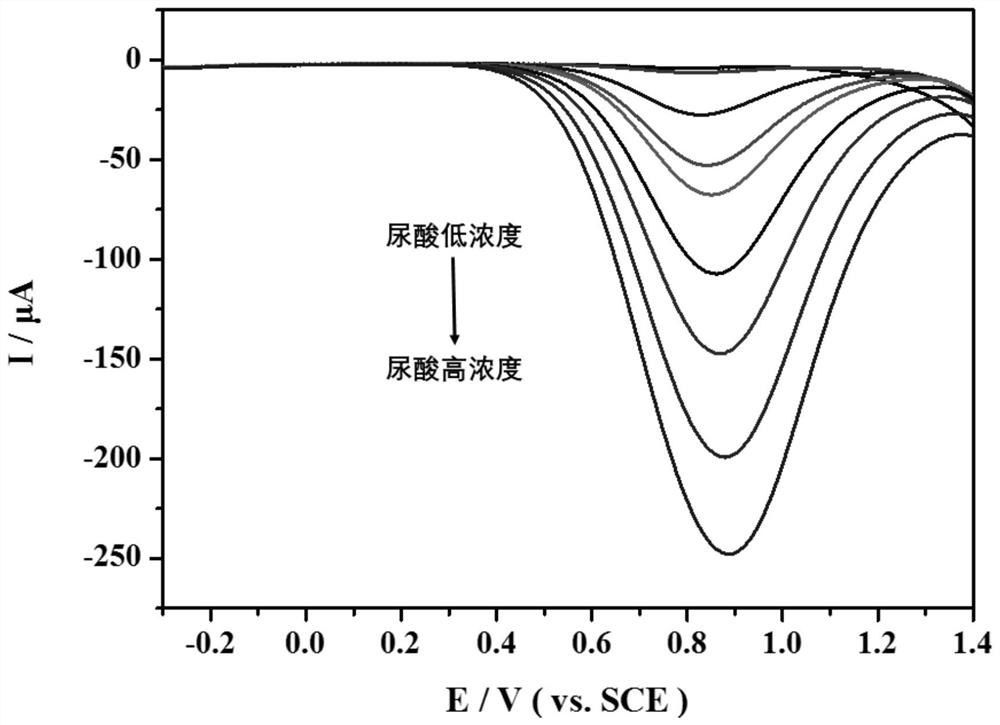Electrochemical sensor capable of simultaneously detecting glucose and uric acid
A sensor and electrochemical technology, applied in the field of non-enzyme electrochemical sensors, can solve the problems of simultaneous detection of glucose and other problems, achieve excellent catalytic ability, reduce costs, and overcome the effects of easy deactivation
- Summary
- Abstract
- Description
- Claims
- Application Information
AI Technical Summary
Problems solved by technology
Method used
Image
Examples
Embodiment 1
[0053] (1) Ultrasonic the ITO conductive glass with a cleaning agent for 30 minutes, then clean it with distilled water, then use acetone, ethanol, and distilled water to sonicate for 5 minutes, then soak the ITO conductive glass in sodium hydroxide solution for 8 hours, and wash it with deionized water Blow dry after rinsing;
[0054] (2) 2.4×10 -2 mol / L sodium citrate solution and 2.4×10 -2 Take 0.5 mL of each mol / L tetrachloroauric acid solution, set the volume to 50 mL, slowly add 0.1 mol / L sodium borohydride solution dropwise under magnetic stirring, stop the dropwise addition when the solution changes from colorless to pink, and prepare A gold nanoparticle solution with an average particle diameter of 158nm was obtained;
[0055] (3) get the gold nanoparticle solution in step (2), 30% stock gel solution, 1.0mol / L 3-hydroxyaminomethane hydrochloric acid buffer (pH=8.8), 5% sodium lauryl sulfate solution, 5% ammonium persulfate solution and tetramethylethylenediamine so...
Embodiment 2
[0062] The preparation method of the sensor based on gold nanoparticle gradient polyacrylamide gel modification described in this embodiment is different from Example 1 in that: in step (3), gold nanoparticle solution, 30% stock gel solution , 2.0mol / L of 3-hydroxyaminomethane hydrochloric acid buffer (pH=8.8), 15% sodium lauryl sulfate solution, 15% ammonium persulfate solution and tetramethylethylenediamine solution according to volume ratio 4.6: 2.7 : 2.5: 0.1: 0.1: 0.006 mixed to prepare gel solution I; in step (5), gold nanoparticle solution, 30% stock gel solution, 1.5mol / L 3-hydroxyaminomethane hydrochloric acid buffer (pH =6.8), 15% sodium lauryl sulfate solution, 15% ammonium persulfate solution and tetramethylethylenediamine solution are mixed according to volume ratio 4.1: 1: 0.75: 0.06: 0.06: 0.006 to obtain a gel solution Ⅱ; The sensor based on gradient polyacrylamide gel modification of gold nanoparticles was prepared.
[0063] The 30% reserve gel solution was p...
Embodiment 3
[0065] The preparation method of the sensor based on gold nanoparticle gradient polyacrylamide gel modification described in this embodiment is different from Example 1 in that: in step (3), gold nanoparticle solution, 30% stock gel solution , 1.5mol / L of 3-hydroxyaminomethane hydrochloric acid buffer (pH=8.8), 10% sodium lauryl sulfate solution, 10% ammonium persulfate solution and tetramethylethylenediamine solution according to volume ratio 2.3: 5 : 2.5: 0.1: 0.1: 0.004 mixed to prepare gel solution I; in step (5), gold nanoparticle solution, 30% stock gel solution, 1mol / L 3-hydroxyaminomethane hydrochloric acid buffer (pH = 6.8), 10% sodium lauryl sulfate solution, 10% ammonium persulfate solution and tetramethylethylenediamine solution are mixed according to volume ratio 1.4: 0.33: 0.25: 0.02: 0.02: 0.02 to obtain gel solution II ; A gold nanoparticle-based gradient polyacrylamide gel-modified sensor was prepared.
[0066] The 30% reserve gel solution was purchased from ...
PUM
| Property | Measurement | Unit |
|---|---|---|
| particle diameter | aaaaa | aaaaa |
Abstract
Description
Claims
Application Information
 Login to View More
Login to View More - R&D
- Intellectual Property
- Life Sciences
- Materials
- Tech Scout
- Unparalleled Data Quality
- Higher Quality Content
- 60% Fewer Hallucinations
Browse by: Latest US Patents, China's latest patents, Technical Efficacy Thesaurus, Application Domain, Technology Topic, Popular Technical Reports.
© 2025 PatSnap. All rights reserved.Legal|Privacy policy|Modern Slavery Act Transparency Statement|Sitemap|About US| Contact US: help@patsnap.com



